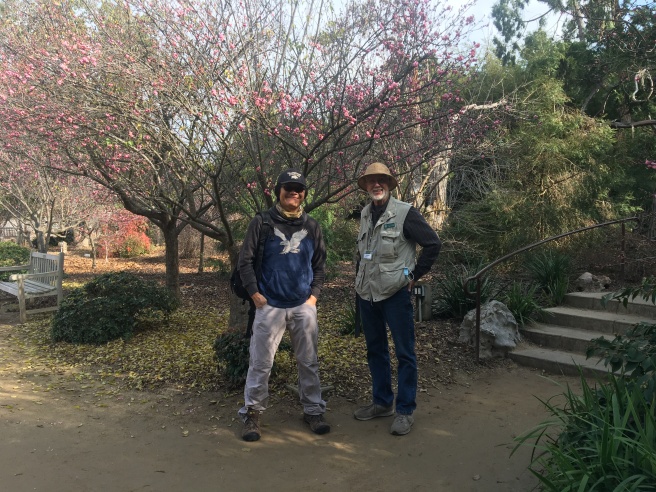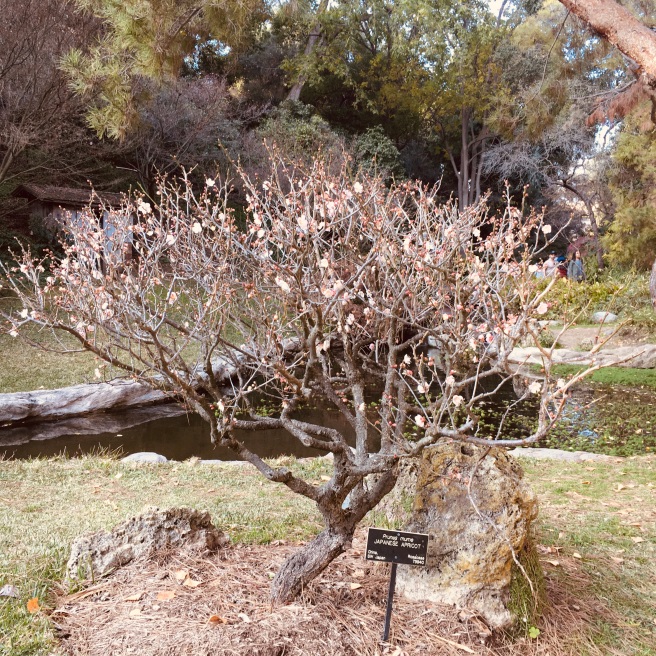Plum Blossoms
Phat Vo
We were born in the tropical part of the country of Vietnam and grew up with images of “yellow plum blossoms,” Ochna integerrima, or “mai” in Vietnamese, every lunar New Year. In school we learned of many poems involving plum blossoms. Little did we know that the plum in ancient East Asian literature is of a different type, Prunus mume.
Plum, or mei in Chinese (ume in Japanese, or mai in Vietnamese) was loved by the literati class since ancient times. But it was not until the Song Dynasty that plum was the plant front and center in philosophy, art, and literature. The neo-Confucian philosopher, Zhu Xi, associated plum tree with four virtues of heaven. The hermit, Lin Bu, called plum his soul mate, and his poem on plum ever since has been considered the best on plum blossoms in Chinese literature. The Zen monk, Shi Zhongren, invented the ink wash painting of plum blossoms on silk. The great literati, Su Shi, praised plum blossoms with phrases like “Bones of Jade, Soul of Ice”. The poet, Lu Yu, wished to transform his body into a million incarnations, each under a plum tree to appreciate it fully. The list goes on and on.
Later this love of plum blossoms has been transmitted to other countries in East Asia. In Japan the use of plum blossoms in art had grown strong among the Zen circles. Eihei Dogen wrote a lively treaty on plum blossoms. Ikkyu Sojun, Hakuin Ekaku, Ryōkan Taigu, Matsuo Basho and Sesshu Toyo contemplated over life with poems about plum blossoms or paintings of plum blossoms.


As we love Japanese culture, and especially as we are into suiseki art, we naturally love plum blossoms. Plum blossom images are everywhere in our kitchen utensils. Plum trees and blossoms are in our sake containers, tea pots, tea bowls, and tea cups. We have ranma (transoms) with plums. We have a few woodblock prints with plum blossoms and bush warblers. We enjoy suiseki with images of plum blossoms from suiseki club members, and wish some day to find a beautiful plum imaged suiseki. And the funny thing was that we had never seen real plum blossoms.
In February 2020 we planned to go to Japan to see the suiseki exhibition and later to experience some plum blossom festivals in Kyoto. The trip was canceled due to COVID-19. We then used our saved vacation in 2020 and 2021 to travel in the USA to find stones, and unexpectedly we found some beautiful ume suiseki. Was it karma?

In January 2022 we overheard that plum trees were blooming at The Huntington Library; we arranged with Jim Greaves to meet with him there to view the plum blossoms, first time for us, and to see Jim’s wonderful suiseki collection at The Huntington. Our excitement spread to Jim. Later that day we came over and stayed overnight at Jim’s house. There in his Japanese tea room under the dim light we enjoyed one of the best suiseki, collected years ago on the Merced River by Jim’s deceased wife Alice, named “Ume over Lake Biwa.” That was a perfect weekend.





Nowadays mei is everywhere. Its image becomes an object of kitschy conformity. But it need not be so. The culture of East Asia has long loved mei for its beauty and admired mei for its spirit. Mei often associates with men of conscience of their day, who could not remain silent before the injustices of the world, who gave honest assessments to the Emperors or their superiors, who were seldom listened to, often punished, sometimes with death. But even so, these gentlemen found solace in mei: its flowers might be destroyed by snow or rain, but the fragrance lingered long afterwards. In this land while we enjoy the beauty and fragrance of mei, our minds could not but recall the spirits of these noblemen of the past, while our hearts go out to the men and women of conscience of today.
Source: http://aisekikai.com/resources/February+newsletter+22.pdf
—

Mai
Võ Tấn Phát
Chúng tôi sinh ra ở xứ nóng miền Nam Việt Nam, và khi lớn lên Tết nào cũng thấy mai vàng, tên khoa học là Ochna Integerrima. Trong trường học chúng tôi đọc nhiều bài thơ về mai, mà không hề biết mai trong thơ văn cổ điển Đông Á là loài mai khác, tên khoa học là Prunus Mume.
Mai — tiếng Trung Hoa là mei, tiếng Nhật là ume, tiếng Anh là plum, hay đôi khi là apricot — được giới văn nhân Trung Hoa yêu thích từ xa xưa. Nhưng phải đến thời Tống, mai mới đứng đầu các loài thảo mộc trong triết học, nghệ thuật, và thơ văn. Nhà triết học Tống Nho, Chu Hi, cho rằng mai có bốn đức lớn của trời đất. Vị ẩn sĩ Lâm Bô coi mai là vợ, và bài thơ của ông vẫn được coi là bài thơ vịnh mai hay nhất trong văn chương Trung Hoa. Thiền sư Thích Trọng Nhân khởi đầu môn vẽ mai bằng thủy mặc trên lụa. Đại văn hào Tô Thức đã tôn sùng mai bằng những câu như “Xương ngọc, hồn băng”. Nhà thơ Lục Du ước gì thân mình được hoá thành trăm nghìn mảnh để mỗi mảnh nằm dưới mỗi gốc mai. Danh sách đó kéo dài vô hạn.
Tình yêu mai sau đó đã lan sang các nước Đông Á khác. Ở Nhật Bản hình ảnh hoa mai bàng bạc khắp chốn Thiền môn. Vĩnh Bình Đạo Nguyên viết một bài pháp ngữ sống động về hoa mai. Nhất Hưu Tông Thuần, Bạch Ẩn Huệ Hạc, Lương Khoan Đại Ngu, Tùng Vĩ Ba Tiêu, Tuyết Chu Đẳng Dương suy ngẫm về nhân sinh qua thơ văn về mai hay họa phẩm vẽ mai.
Vì chúng tôi yêu văn hoá Nhật, và nhất là vì chúng tôi mê đắm nghệ thuật thủy thạch, lẽ tự nhiên là chúng tôi yêu mai. Hình ảnh mai có khắp nơi trên các vật dụng trong nhà bếp. Mai cũng có cùng khắp trên bình rượu, bát trà, bình trà, chén uống trà. Nhà chúng tôi trang trí bằng khung cửa sổ gỗ của Nhật khắc hình mai. Chúng tôi mua những bức tranh khắc gỗ có hoa mai và chim oanh. Chúng tôi yêu thích những hòn thủy thạch hình mai của những thành viên của các hội thủy thạch, và ước một ngày nào đó tìm được một hòn thủy thạch hình mai. Điều nực cười là chúng tôi chưa hề thấy mai thật ngoài đời.
Vào tháng hai năm 2020 chúng tôi đã chuẩn bị tất cả mọi thứ để du lịch Nhật Bản, đến tham quan cuộc triển lãm thủy thạch quan trọng, rồi đến Kyoto tham dự các hội hoa mai. Chuyến đi bị hủy bỏ vì COVID-19. Trong hai năm 2020 và 2021 chúng tôi để dành những ngày nghỉ phép để đi dạo khắp nước Mỹ tìm đá. Rồi bất ngờ chúng tôi tìm được vài hòn thủy thạch hình mai rất tuyệt. Có duyên nợ gì nhau chăng?
Tháng giêng năm 2022 chúng tôi đọc được tin ở Huntington Library hoa mai đang nở ở vườn Trung Hoa và vườn Nhật, nên chúng tôi sắp xếp với ông Jim Greaves gặp nhau để ngắm hoa, là lần đầu tiên chúng tôi nhìn thấy hoa mai, và sẵn dịp thưởng thức bộ sưu tập thủy thạch của ông ở đó. Sự hào hứng của chúng tôi cũng lây sang Jim. Tối đó chúng tôi đến nghỉ lại nhà của Jim. Trong căn trà thất kiểu Nhật, dưới ánh sáng mờ ảo, chúng tôi được thưởng ngoạn một trong những viên thủy thạch đẹp nhất, “Mai trên Hồ Tỳ Bà”, do người vợ quá cố Alice của ông tìm thấy nhiều năm trước trên sông Merced. Một kỷ niệm cuối tuần tuyệt hảo!
Hôm nay mai có mặt khắp nơi. Hình ảnh mai trở thành thời thượng sếnh sáo. Nhưng mai đâu phải thế. Nền văn hoá Đông Á từ xưa đã yêu mai vì đẹp và kính mai vì thần. Mai thường đồng hành với những bậc quân tử gánh vác lương tâm thời đại của họ, những người không thể lặng thinh trước bất công của thế gian, dám cất lời trung nghĩa với Hoàng đế hay với quan trên, ít được lắng nghe, thường bị trừng phạt, đôi khi bị xử chết. Nhưng dù vậy, họ vẫn tìm được niềm an ủi ở mai: dù hoa mai có bị vùi dập tan nát trong mưa bão tuyết giá, hương mai vẫn lưu mãi về sau. Ở chốn này khi chúng ta vui hưởng vẻ đẹp và hương thơm của mai, trí ta không khỏi nhớ lại khí phách của những bậc trượng phu của quá khứ, tâm ta không khỏi hướng về những tù nhân lương tâm của hôm nay.
Nguồn: http://aisekikai.com/resources/February+newsletter+22.pdf

